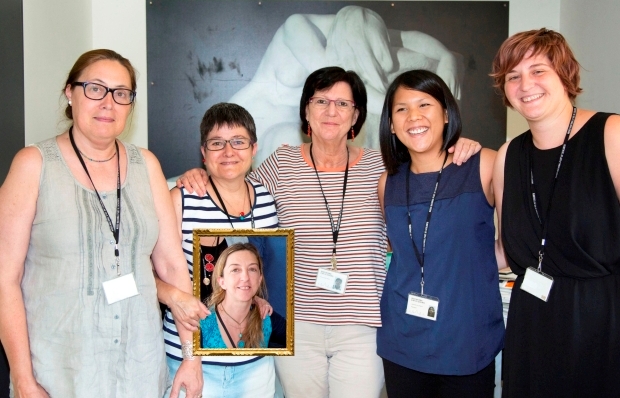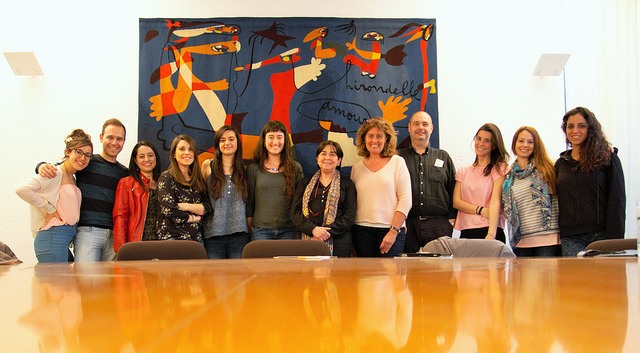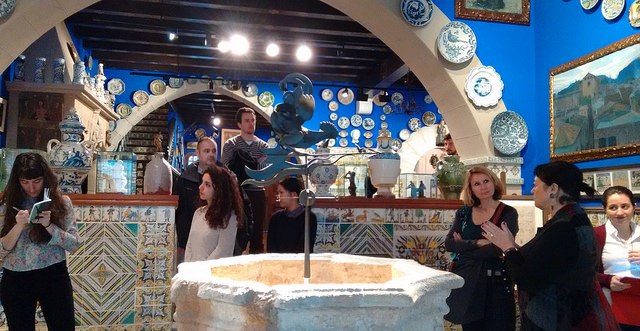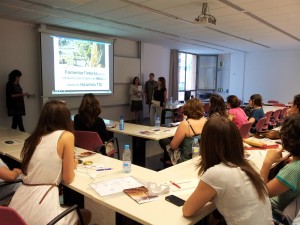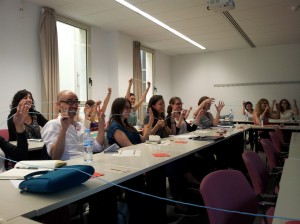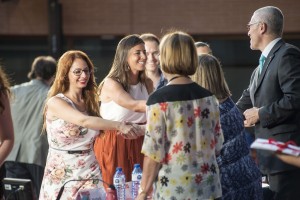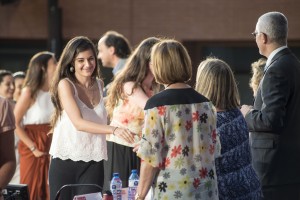Conxa Rodà
When in 2009, at that time in the Museu Picasso, I received a proposal to think about the academic programme for a new Postgraduate course in Museum Management, the first thing I did, as when beginning any project, was to carry out a prospective analysis of the existing offer.
Searching for singularity
There are various master’s degrees and postgraduate degree courses in museums and heritage centres from diverse universities of the country. Once I had analysed the contents, I noticed that there was a gap where a differentiation could be found: the practical applicability. The majority of the existing programmes adopted a theoretical and academic point of view. Assessing the situation with the director of the museum, Pepe Serra, we saw that if we designed a curricular programme which focused on practice, it could not only be a differential feature but would also be an authentic offer of value. And so in this way the postgraduate course, of which we are bringing to a close the fifth edition, was born.
Linking the approach to practice, we took the decision that the teaching team should be mainly formed by museum professionals. Ideally with teaching experience. And from various fields of work, so as to provide a comprehensive vision of the tasks of the museum. Thus, the following have passed through the postgraduate course: directors, educators, conservators, restorers, communicators, curators of exhibitions, designers, CEOs, people in charge of security, from administration, from public programmes or from museum libraries. In addition to museums of Catalonia we count as faculty members with professionals from Museo del Prado, Museo Thyssen and Guggenheim Bilbao. From the international sphere, have taught classes –either in person or via videoconference– professionals from MoMA, Smithsonian, National Gallery in London and the Muséum of Toulouse, France, among others.
Social media have formed an integral part of this postgraduate course since the outset. The blog has been especially active, written and managed entirely by the students, and also the Twitter profile, @dgesm.
Another specificity has been the fact that it was the first postgraduate course to be entirely co-directed and co-produced between a museum and a university, in this case, the UPF (The Pompeu Fabra University). The programme, once it was approved by the Board of Studies of the IDEC (Institute of Lifelong Learning of the UPF) started with the 2010-2011 course.
Visits to museums
The visits to the museums and heritage centres form part of the academic programme. These are not so much visits to the collections, something that the participants can always do on their own, but their aim is to provide an encounter-conversation with the professionals from the centre.
In some museums the group is attended by the director (Museu Nacional, MuHBA, Museu Blau, Sitges), in others by the conservator (Fundació Miró) or restorers (Museu Nacional, MACBA), the manager (F. Miró), or public programmes (Museu Picasso), etc. In these sessions, a vision is provided from within with regard to the management of the museum and its activity. Depending on the calendar of exhibitions, visits are also programmed with the curators.
Final projects
The carrying out of the final project takes up a lot of time and effort throughout the course. It is, at the same time, what brings the greatest satisfaction once it has been completed and presented in class. It’s not only the final product that is important, but it is just about as important the development process itself: from the fitting in of the different members of the group to the constructive discussions and the decisions taken throughout (extending, reducing, going off on a parallel way, reorienting, etc.).
The majority of the projects have successfully put their finger on where the museums suffer from a lack or presented an opportunity. From strategic plans to proposals for reopening centres or participatory projects, the projects have covered a variety of topics and issues where they were able to apply what they had learnt throughout the course, and from their own reflection and experience. Most of the projects could be carried out if the economic context was better. Some have even come to light, as it the case of Enfilant el museu comunitari (Heading the museum community) which was presented in public in April 2014.
Internships
The possibility of carrying out practice, or internships, in the collaborating museums has become one of the attractive elements. There’s nothing like experiencing from the inside what is explained in class. The academic coordination of the postgraduate course acted as a bridge between the centres opened to receiving interns, and a distribution of the curriculums was made according to the profiles of the students and their preferences in terms of museums or departments. The internships were formalized by means of an agreement signed between the host museum and the IDEC-UPF. We “collocated” on average around 90% of the students who applied for internships.
If well focused, the internships represent a benefit for both parts. For the students it is a magnificent opportunity to experience the museum from the inside [post in Catalan written by a student], of learning about the functioning, the processes, the difficulties and the results. For the museums, after an initial investment of time and dedication, it represents an additional support for the work and a fresh injection of an external vision, often young.
My direct experience with the different interns that we have had, first at the Museu Picasso and now at the Museu Nacional, has been extraordinarily positive. Both from the point of view of professional performance (they’ve done a lot of work!) and in terms of personal relations. From here I throw up the challenge in favour of good interns – the majority –as well as some recommendations for the hosting museum:
- Integrate them as one more member of the team
- Invite them to participate in the project meetings
- Pass on interesting work to do (or if they have to do routine tasks, make sure it’s not exclusively this)
- Don’t forget that it’s a training experience
The interns contribute new blood, enthusiasm, initiative and are keen to work, qualities that, sometimes, not everyone from within the organisation have….
After the postgraduate course
It is true that the current labour market panorama is not the best. In the public museums, the possibility of contracting new people has been just about zero for the past three years. But it is also true that the preparation achieved in the postgraduate course has facilitated in some cases the finding of related work.
It is a cause of great happiness when any ex-student tells us that in their new job as exhibitions assistant or as a community manager, for example, what they learnt in the course has been very useful. Or the fact that we have been able to help others to get an internship in museums abroad. They are, of course, not the majority, and it isn’t our first objective either, just as we warn them in the prior informative sessions. But in each promotion, as well as the acquisition of knowledge and the fact of making direct contact with professionals, we are able to help some of them to get work or improve how they work, and that in itself fills us with satisfaction. Furthermore, the relationship between students will be a lasting one, and this has sometimes led to them embarking on a working adventure together.
What the students say…
I copy as a sample, some of the reflections of the participants. As you can see, we learn together because they make many good contributions:
“Today in the museum we have to propose if we want to be somebody different. It’s not easy changing customs (and less so when these are acquired from the parents, grandparents, etc.), But today it’s our turn to do the laundry. It’s inevitable. The dilemma between essence and renovation is somewhat conflictive, but it is the only way for museums to maintain the balance on one foot”.
“The museum ‘will be’ relevant and will have relevance in the coming world, not to the extent of it containing works of art but of being capable of highlighting their value within the contemporary world, and this will be achieved by getting out and going beyond the walls of the museum and projecting the museum towards the outside, to the world, to the net […] the most ground-breaking and valuable discourses will come from the periphery”.
“Museums have to manage their message better, to learn how to explain themselves better. Now what’s missing is the dialogue. A lot of dialogue. Museums have to listen to their audiences”.
“The major challenge for the museums and the museologists of the future will be to achieve the fact that both the space and the interior design become more inclusive, turning the museum into a pleasant place, one which is accessible, usable and comfortable. In this way, the benefit will be for everyone given that it will be perceivable for everybody”.
“One of the reasons why I enrolled in the Postgraduate Course in Museum Management was to be able to carry out an internship in a museum, so as to get to know first-hand how they work there, and because of the saying that “theory is one thing and practice is another”.
A relevant figure: 89% of the students would recommend the postgraduate course. We have to continue improving it, for sure, but this figure highlights the fact that we are going in the right direction.
Improvements carried out and foreseen
In essence, the structure and functioning of the postgraduate course continues to be the same as in its origins. But in each course we have kept on fine tuning both the contents and the teaching staff. And we have introduced some adjustments and new items. Some in terms of the format: workshops, webinars, roundtables. Others regarding the topics, which five years ago weren’t so relevant or known: web analytics, social responsibility, storytelling, content strategy, to mention just a few.
We will continue to very much keep in mind the comments of the participants, teachers and students, either by means of informal conversations or the evaluations. We know that we need to intensify the inclusion of small museums, and those from outside Barcelona, in the programme. Although the analysis and model of what the major museums of the world do help to open up a vision and provides valuable references, what is true that within the Catalan panorama of museums, the museums that predominate are the small-sized ones, with little provision of staff and very specific and pointed management needs that should be known well.
From the IDEC, they are also reviewing and rethinking in a strategic way the teaching model so as to advance more in the adaptation of the programmes to the specific needs and interests of each participant. The change, led by the rector Jaume Casals will stress experiential learning, interdisciplinary skills, personalisation, innovation and the establishment of more synergies between the master’s degrees and postgraduate degrees themselves, as lines in the short-term future.
Promotion 2014-2015 in the graduation event, receiving the diploma from the rector Jaume Casals and from the director of the IDEC, Carme Martinell. At the back, Pepe Serra, director of the Museu Nacional and co-director of the postgraduate course, congratulating the graduates.
As Pepe Serra says, director of the Museu Nacional and of the postgraduate course, “the museum has to reinvent itself continually. You need to be audacious and have a critical vision, to take a lot of risks and to generate critical spectators and users”. Referring to this last point, this is what we are trying to do on the postgraduate course.
In the Museu Nacional we consider it to be an honour to direct this postgraduate course together with the IDEC-UPF and we would like to pass on our gratitude to the teachers and for the active and intense participation of the students. From our side, we place at their service our knowledge, experience and effort. But I can assure you that we also get a lot back in the form of a fresh and critical vision, of motivation, and the fact of getting to know in each course great people and great professionals.
The enrollment for the next course [in Spanish] is already open!
Which training needs do you think we are still lacking in museums? What topics and skills would you like to see tackled?
Related links
Our Postgraduate Course in Museum Management under Exam: Assessments and Improvements, 2011
My experience in California after the Museum Management postgraduate, 2012
Forming part of the MNAC_museum [in Catalan], 2012
Co-directora del Curs d'Estratègia Digital_UOC_Museu Nacional d'Art de Catalunya
Co-directora del congrés CIMED de Museos y Estrategias Digitales

